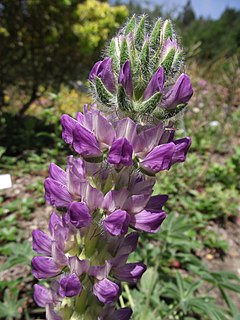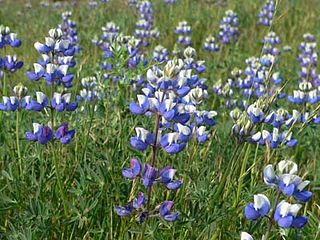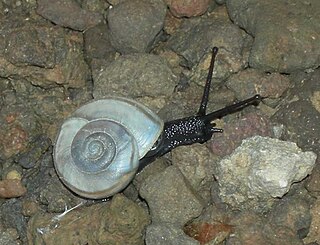
Lupinus polyphyllus, the large-leaved lupine, big-leaved lupine, many-leaved lupine, blue-pod lupine, or, primarily in cultivation, garden lupin, is a species of lupine (lupin) native to western North America from southern Alaska and British Columbia east to Quebec, and western Wyoming, and south to Utah and California. It commonly grows along streams and creeks, preferring moist habitats.

Lupinus, commonly known as lupin, lupine, or regionally bluebonnet etc., is a genus of flowering plants in the legume family Fabaceae. The genus includes over 199 species, with centers of diversity in North and South America. Smaller centers occur in North Africa and the Mediterranean. They are widely cultivated, both as a food source and as ornamental plants, although in the Nordic countries and New Zealand's South Island, introduced lupins are viewed as a severe environmental threat.

The Xerces blue is an extinct species of butterfly in the gossamer-winged butterfly family, Lycaenidae. The species lived in coastal sand dunes of the Sunset District of San Francisco Peninsula. The Xerces blue is believed to be the first American butterfly species to become extinct as a result of loss of habitat caused by urban development. The last Xerces blue was seen in 1941 or 1943 on land that is part of Golden Gate National Recreation Area.

Lupinus arboreus, the yellow bush lupine (US) or tree lupin (UK), is a species of flowering plant in the legume family Fabaceae.

Lupinus microcarpus, the wide-bannered lupine or chick lupine, is a species of lupine native to western North America from southwestern British Columbia south through Oregon and California, including the Mojave Desert, and into Baja California. There is also a disjunct population in South America, with locations in central Chile and western Argentina.

Lupinus nanus, the sky lupine, field lupine, dwarf lupin, ocean-blue lupine or Douglas' annual lupine, is a species of lupine native to the western United States. It is found natively in California, Nevada, and on Steens Mountain in eastern Oregon. It tends to grow on slopes and in open or disturbed areas below 1300 meters.

Lupinus angustifolius is a species of lupin known by many common names, including narrowleaf lupin, narrow-leaved lupin and blue lupin. It is native to Eurasia and northern Africa and naturalized in parts of Australia and North America. It has been cultivated for over 6000 years as a food crop for its edible legume seeds, as a fodder for livestock and for green manure.
Lupinus foliolosus is a species of legume in the family Fabaceae. It is found only in Ecuador. Its natural habitat is subtropical or tropical high-altitude grassland.
Lupinus kuntii is a species of legume in the family Fabaceae. It is found only in Ecuador. Its natural habitat is subtropical or tropical high-altitude grassland.
Lupinus michelianus is a species of legume in the family Fabaceae. It is found only in Ecuador. Its natural habitat is subtropical or tropical high-altitude grassland.
Lupinus nubigenus is a species of legume in the family Fabaceae. It is found only in Ecuador. Its natural habitat is subtropical or tropical high-altitude grassland.
Lupinus rupestris is a species of legume in the family Fabaceae. It is found only in Ecuador. Its natural habitat is subtropical or tropical high-altitude grassland.
Lupinus smithianus is a species of legume in the family Fabaceae. It is found only in Ecuador. Its natural habitat is subtropical or tropical high-altitude grassland.

Sonorella allynsmithi is a species of land snail in the family Helminthoglyptidae. It is native to Arizona in the United States.
Beauprea congesta is a species of plant in the family Proteaceae. It is endemic to New Caledonia.
Helicia neglecta is a species of plant in the family Proteaceae. It is endemic to Papua New Guinea. It is threatened by habitat loss.

Lupinus excubitus is a species of lupine known as the grape soda lupine. Its common name refers to its sweet scent, which is said to be very reminiscent of grape soda. This species and its variants are found in Southwestern United States, especially in California and Nevada, e.g., Death Valley and Joshua Tree National Parks, and northwestern Mexico.
Lupinus antoninus is a rare species of lupine known by the common name Anthony Peak lupine. It is endemic to northern California, where it is known from only four occurrences in the North Coast Ranges, including near Anthony Peak.

Bluebonnet is a name given to any number of purple-flowered species of the genus Lupinus predominantly found in southwestern United States and is collectively the state flower of Texas. The shape of the petals on the flower resembles the bonnet worn by pioneer women to shield them from the sun. Species often called bluebonnets include:

Lupinus pubescens is a lupine flower which is native to the high Andes, but can also be found in China, Colombia, Ecuador, and Venezuela.











